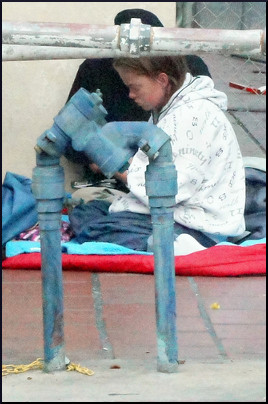
“If you’re going to San Francisco, be sure to wear some flowers in your hair,” went the refrain of a once-popular song. California was Shangri-la, a land of magic and hope, the preferred destination for the abandoned and disaffected youth of our entire nation.
These days, it’s a good place for homeless teens and young adults to steer clear of. With facilities stretched to their limits, helping organizations work harder than before, trying to accomplish more with ever-shrinking budgets. Housed people fall prey to compassion fatigue, and there is a steady increase in laws designed to make life unpleasant for the peasant.
Currently, the golden state contains more homeless youth than any other state, and they are more likely to be unsheltered than in most other states. Among the nation’s cities as rated by their “mean streets,” California has three of the top ten spots.
The last two decades have seen the creation of numerous restrictive ordinances, and over the past five years, the pace of anti-homeless legislation has picked up, according to Shahera Hyatt and Jessica Reed, the credited authors of “Adding Insult to Injury: The Criminalization of Homelessness and Its Effects on Youth.” Though only two names are on the cover, this 16-page report utilized all the resources of the California Homeless Youth Project, with help from the National Law Center on Homelessness & Poverty.
Things Are Tough for Unaccompanied Youth
Many of the offenses that people experiencing homelessness are charged with have nothing to do with age. They may be forbidden to sit, stand, rest, or sleep in public places; or to set up a tent or lean-to shack anywhere. They may not be allowed to ask for contributions or sort through trash receptacles for food or recyclable materials. Organizations that want to serve them food may be told they are not allowed to give away so much as a sandwich.
Then there is another layer of legal difficulty known as selective enforcement, when homeless people are not allowed to do things that are apparently okay for others. The most well-known example is sidewalk camping. People who wait in line all night to buy concert tickets or the latest model phone are allowed to set up tents or sack out in sleeping bags while homeless people, of course, would be breaking the law.
The things that unaccompanied youth most often get in trouble for are, the report says, “sleeping in public or private spaces at night, or sitting in public space during the day.” The other big problem is traveling to places where help is available. Kids often sneak rides on public transportation and get nailed for theft of services.
Age-Related Crimes
Then there is the problem of “status offenses,” or things that are illegal for a person under 18 to do unless a court has previously deemed her or him an “emancipated minor.” Curfew violations get kids in trouble while not affecting adults. Kids are supposed to be enrolled in school until a certain age, and not showing up makes them truant. Truancy is a crime even for the homeless. Young people have been locked up for that crime, which makes no sense whatsoever. Incarcerating a kid for skipping school has got to be one of the most irrational government actions ever. The report says:
Homeless students are much better served by community-based organizations, which have been shown to be more developmentally appropriate, cost effective, and humane than the juvenile justice system.
For an adult, running away from home may not always be the wisest choice, and can even cause problems to multiply, but at least it isn’t illegal in and of itself. But for a minor (which in California means under 18), mere existence is a status offense, because kids that age are not supposed to be anywhere else except under their family roof. Here is what the authors say:
Youth who run away do so for their own survival, often fleeing their homes due to abuse, extreme poverty, and/or rejection of their sexual orientation and/or gender identity and expression. Yet in many jurisdictions, runaway youth may be apprehended by law enforcement and returned to their home of origin, even if that home is dysfunctional and/or abusive.
Reactions?
Source: “Adding Insult to Injury: The Criminalization of Homelessness and Its Effects on Youth.
September 2015
Image by Senia L


